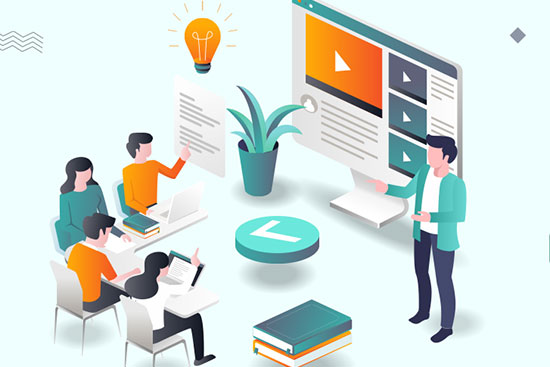A Comprehensive Guide to Curriculum Development: Types, principles & process of Curriculum Development
Get Your Free Trial Now!
Curriculum Development
Curriculum development assumes an essential part in the learning climate of undergrads, graduates, and understudies, as it is the determinant of growth opportunities in schools, universities, and colleges. Through the very well-planned educational program, we provide a guide for instructors and teachers to utilize when they guide understudies to get the important information and necessary abilities they need to find lasting success in the quickly impacting world.
The instruction is purposefully shaped to demonstrate the educator's knowledge of pedagogy concepts such as experiential learning, collaborative activities, gap analysis, and assessments that capture student knowledge.

Types of Curriculum
Having known all this, it is time to make things clear through a curriculum guide. There are three primary types:
Explicit or Formal Curriculum
It is the official curriculum as put out by educational institutions, which includes subjects, content, and skills to be taught to the students. It is often written in uniform order.
Implicit or Hidden Curriculum
Besides the official curriculum, an implicit one exists that incorporates the lessons of values, attitudes, and behaviour that students obtain through the social environment of educational institutions. This is not in the teachers’ classroom instructions but through interactions and experiences.
Null Curriculum
It means either the knowledge or ability that is omitted or not mentioned in the curriculum, though it is intended to be sold as a component part of teaching. Knowing the null curriculum is an important thing for educators because they should keep the gaps in students’ learning in mind.
Principles of Curriculum Development
Flexibility
A good curriculum should be designed in a way that it is flexible to changing student’s purposes and changing society. It should facilitate enhancement and improvement over time, which corresponds to the fact that knowledge and technology development do not stop.
Integration
Subjects and topics should be linked together to give an adequate awareness of the main theme. Integration forms the interdisciplinary educational system, which brings an understanding of the interconnectivity of the body of knowledge.
Don’t Miss Out : Advantages of School ERP in Adapting to NEP 2020 Changes
Evaluation
The plan of appraisal techniques ought to help demonstrate the objectives of the instructive program. The appraisal framework involves both developmental and summative evaluations for surveying understudies' presentations as well as the educational plan.
Inclusivity
The educational program ought to stick to variety by thinking about the distinctions in the students' experiences, learning styles, and capacities. The arrangement ought to be planned in a way that embraces the variety of the multitude of understudies' mentalities, with instruction as the way to empowering equity.
Processes of Curriculum Development
Formulating an influential curriculum requires a step-by-step process that facilitates educators through the different stages of development. Formulating an influential curriculum requires a step-by-step process that facilitates educators through the various stages of development.
Needs Analysis
Set the learners educational needs considering the data they already possess regarding their level of awareness, interests, and the existing socio-cultural setup. The steps of a planner’s job are the basis of curriculum planning.
Setting Objectives
Wait a minute; define learning objectives and outcomes. These goals must be detailed, measurable, attainable, relevant, and SMART.
Organizing Content
Structure the information in a logical form, taking into accounts the developmental levels and cognitive faculties of students. An organized curriculum is a good platform for swift development, aided by instructions.
Instructional Strategies
Establish the modes of delivery and the approaches to be used to deliver the content. This could include different methods such as lecturing, discussing, doing practical activities, and technology-supported learning.
Assessment Design
Create a test with methods that tally with learning objectives. This entails building the tests, quizzes, projects, and other evaluation techniques to test and determine the level of student understanding.
Implementation
Deliver curriculum in the classroom and track student involvement and comprehension. The teachers take up the job of standardizing the approach to delivering the subject.
Evaluation and Feedback
Regularly assess the efficacy of the curriculum by means of assessments from students, teachers, and other stakeholders. Reflect on the evaluation data to make changes where needed.
Read Also : What is Gap Analysis: Importance, Benefits And Guide
Conclusion
In the end, this design curriculum guide involves the creation of a good and useful program for educating (my spelling is wrong). Through analyzing the kinds, principles, and procedures involved, educators can design courses aimed at satisfying the specific requirements of the students and thus preparing them for success in the 21st century.
A meaningful, relevant, and adaptable curriculum development with a purposeful and well-planned approach provides for memorable and life-long learning experiences that change with the ever-evolving educational environment. In the context of fostering quality in education, the guide to curriculum development has proven to be a useful tool for constructing exciting learning nooks.

FAQs
What is ‘curriculum development', and why is it of paramount concern?
Curriculum development is the process of writing a text, establishing an outline, teaching methods, objectives, etc. Curriculum development is a systemic approach for appraising the importance of learning and ensuring that the learning ties with the needs of students.
Why is curriculum development so essential?
After curriculum development, we are one step ahead because it determines the quality of education. The developed curriculum that is tailored to students' needs will grant them access to the knowledge, skills, and attitude that will help students achieve academic and professional achievements. In that regard, it continuously changes as a result of developments in society, technology, and educational theories.
What kind of curriculum exists?
There are three main types of curriculum: overt or formal curriculum (subjects that are purposely taught), covert or hidden curriculum (social interactions through which values and behaviours are learned), and null curriculum (aspects that are consciously left out or not taught).